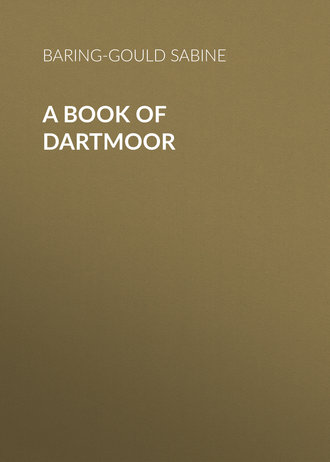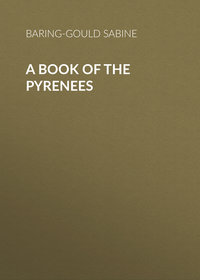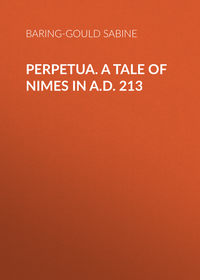 полная версия
полная версияA Book of Dartmoor
Then came the eighteenth and nineteenth centuries, when granite was in demand for gateposts, and every standing stone serviceable was ruthlessly carried away. Almost every circle of upright stones has lost some of its finest blocks in this way, and all that is left to show where they were is the hole cut in the "calm" from which they were extracted, and the spalls or chips made by the quarrymen as they knocked the block into shape. At Sherberton was a fine circle: the three largest stones have been employed a few yards off as gateposts, and two others have been cast down.
Next came the newtake-wall builders. The ravage they have wrought is incalculable. In 1848 S. Rowe published his Perambulation of Dartmoor, and gave an illustration of double stone rows that ran from the Longstone, near Caistor Rock, for half a mile to the Teign. In 1851 I planned them. A few years ago a farmer built a newtake wall, and used the rows as his quarry; nothing now is left of them but a few insignificant stones he did not consider worth his while to remove. The stones are in the wall, and can be recognised, and the socket-holes can all be traced, with a spade.
There was a row or set of rows of stones on a common near Leusden. In 1898 the road-menders destroyed it and employed the stones for the repair of the Ashburton highway.
Now it is quite possible that the old rude stone monument builders did not erect really mighty structures on Dartmoor, but it is still more likely that all such as were of any size have been carried away. Lake-head Hill, near Post Bridge, must at one time have been a veritable necropolis. The farmer at Bellever was given his holding on a rent that was to be mainly paid by inclosing new-takes, and repairing old walls. For six years he was employed in clearing Lake-head Hill of all the stones he could find. Thousands of loads were removed, and it is only by a lucky chance that one or two kistvaens have escaped. Three pounds with their huts, probably scores of kistvaens, and certainly several stone rows, have been obliterated by this man. In 1851 I drew the finest moor kistvaen at Merrivale Bridge. The covering stone measured 9 feet 3 inches by 4 feet 9 inches. In 1891 a man at Merrivale Bridge wanting a gatepost, cut one out of the capstone and left only two scraps in situ.
Considering the ruthless manner in which these monuments of a hoar antiquity have been carried away or destroyed, it is a marvel that any remain; but then, this devastation explains why those allowed to remain are such only as were considered too insignificant to offer inducement to the plunderer. The late Mr. Bennett, of Archerton, when inclosing and planting, utilised a fine pound for a clump of beech. The old inclosing ring was used up to make a wall for the protection of the young trees, and these latter, in growing, threw all the huts that had not been despoiled out of shape and into inextricable confusion.
Let us now take in their order such monuments as remain, and I will say a few words about each kind.
1. Of the characteristic dolmen, which we in England perhaps improperly call cromlech, we have but a single good example, that at Drewsteignton. The dolmen was the family mausoleum. It is composed of several large slabs set upright in box-form, and covered with one or more large stones, flat on the under side. These were probably all originally covered with earth, but in course of time the earth has been washed or trodden away. In some cases the dolmen becomes the allée couverte, a long chamber or hall constructed of uprights and coverers. The most magnificent example is that at Saumur, on the Loire, which is over 62 feet long and 13 feet wide, and high enough for a tall man to walk about in it with ease.
In these the dead were interred, not burnt, and their bones seem to have been taken out on anniversaries, scraped, and then replaced; and remoter ancestors were huddled into the background to make room for newcomers.
In time the fashion for carnal interment gave way to one for cremation.
Now of the large dolmen or cromlech we have only the fine Drewsteignton example, and that deserves a visit. Formerly it was but one of a number of monuments, lines and circles of upright stones. All these have been destroyed in this century.
But although this is the sole remaining example, we know by place names that anciently there were many more. These monuments have everywhere a local designation. In France they are pierres levées or cabannes des fées. In Devon they were shelf-stones, and wherever we meet with a farm called Shilston, there we may confidently assert that a dolmen formerly existed. With a little search the portions of it may occasionally be recognised in pigsties, or worked into the structure of the house.
The parish of Bradstone derives its name from the broad coverer of a cromlech, which is now employed as a stile. The supporters have disappeared, used probably for the church. There is a shilstone in Bridestowe, and another in Modbury. In dolmens it is usual to have a hole in the end stone, and even sometimes closed with a stone plug, or else a small stone is employed that could easily be removed, so as to enable those who desired it to enter and put therein food for the consumption of the dead, or to remove the remains for the annual scraping, or again for the introduction of a fresh tenant.
2. When carnal interment gave way to incineration, at once the need for large mausoleums ceased, and mourners saved themselves the labour of erecting huge cromlechs, and contented themselves instead with the more modest kistvaen, or stone chest. This is constructed in precisely the same manner as the dolmen, but is much smaller. A beautiful diminutive example, from Peter Tavy Common, has been transported to the Plymouth Municipal Museum. It measures 21 inches long, 13 inches wide, and 14 inches deep. On Dartmoor there are many hundreds of these kistvaens, of various sizes, but most have been rifled by treasure-seekers; indeed, all but such as were covered with earth and so escaped observation have been plundered.
The kistvaens were always buried under cairns, and almost invariably a circle of stones surrounded the cairn, marking its bounds.
The finest kistvaens are – one at Merrivale Bridge, one adjoining a pound near Post Bridge, one on Lake-head Hill, one near Drizzlecombe, one on Hound Tor, and two on the slope of Bellever. One is near the Powder Mills. There are several, also, about the Plym.
3. The stone circle is called by the French a cromlech. The name means curved stone. The circle, of which Stonehenge is the noblest known example in Europe, consists of a number of stones set up at intervals in a ring. The purport is purely conjectural. Undoubtedly interments have been made within them; but none, so far, have been found in those on Dartmoor. In the great circle on Penmaen-mawr there were burials at the foot of several of the monoliths, and, indeed, one of these served as the back-stone of a kistvaen.
Among semi-barbarous tribes it is customary that the tribe should have its place of assembly and consultation, and this is marked round by either stones or posts set up in the ground. Among some of the great clan circles, if one of the constituent tribes fails to send its representative, the stone set up where he would sit is thrown down.
The areas within the circles on Dartmoor, so far as they have been examined, show that great fires have been lighted in them; the floors are thickly bedded in charcoal. It may be that they were the crematoria of the tribe, and certainly numerous cairns and kistvaens are to be found around them; or it may be that great fires were lighted in them when the tribe met for its parliament, or its games and war-dances. It has been noticed that usually these circles of upright stones are placed on the neck of land between two rivers.
Some have speculated that they were intended for astronomical observation, and for determining the solstices; but such fancies may be dismissed till we have evidence of their being erected and employed for such a purpose by some existing savage race.
The Samoyeds were wont to make circles of stones of rude blocks set up, and these are still to be seen in the districts they inhabit; and although these people are nominally Christians, yet they are secretly addicted to their old paganism. Mr. Jackson, in his Great Frozen Land (London, 1895), says: —
"The rings of stones which I frequently met with in Waigatz are the sites of their midnight services, and are made, of course, by the Samoyeds. They are called yon-pa-ha-pai. It is possible that within these circles the human sacrifices with which Samoyeds used to propitiate Chaddi were offered up; and, although these are things of the past now, it is only a few years ago that a Samoyed, living in Novaia Zemlia, sacrificed a young girl" (p. 89).
A tradition or fancy relative to more than one of these circles is that the stones represent maidens who insisted on dancing on a Sunday, and were, for their profanity, turned into stone when the church bells rang for divine service. It is further said that on May Day or Midsummer Day they dance in a ring.
There are several of these circles on the moor. The finest are those of Scaur Hill, near Chagford, of the Grey Wethers – two side by side, but most of the stones of one are fallen – the circle on Langstone Moor above Peter Tavy, Trowlesworthy, Sherberton, and Fernworthy. The diameters vary from thirty-six feet to three hundred and sixty. One that must have been very fine was near Huccaby, but most of the stones constituting it have been removed for the construction of a wall hard by.
The number of stones employed varies according to the area inclosed.
4. The stone row is almost invariably associated with cairns and kistvaens, and clearly had some relation to funeral rites. The stone settings are often single, sometimes double, or are as many as eight. They do not always run parallel; they start from a cairn, and end with a blocking-stone set across the line. In Scotland they are confined to Caithness. The finest known are at Carnac, in Brittany. It is probable that just as a Bedouin now erects a stone near a fakir's tomb as a token of respect, so each of these rude blocks was set up by a member of a tribe, or by a household, in honour of the chief buried in the cairn at the head of the row.
It is remarkable how greatly the set stones vary in size. Some are quite insignificant, and could be planted by a boy, while others require the united efforts of three, four, or even many men, with modern appliances of three legs and block, to lift and place them in position. This seems to show that the rows are not the result of concerted design, but of individual execution as the ability of the man or family permitted to set up a stone large or small. Usually the largest stones are planted near the cairn, and they dwindle to the blocking-stone, which is of respectable size.
There is no district known so rich in stone rows as Dartmoor. As many as fifty have been observed. The finest are those of Drizzlecombe, where there are three double rows, not parallel; Down Tor, a single line; Merrivale Bridge, two parallel double rows, but the stones constituting them small; Stall Moor, a single line that looks like a procession of cricketers in flannels stalking over the moor; Challacombe; at Glazebrook are thirteen rows; also Staldon Moor. Some of these rows which are small are nevertheless instructive. On the north slope of Cosdon is a cairn that originally contained three kistvaens, one of which is perfect, one exists in part, and evidence of the existence of the third was found on exploration. From this cairn start three rows of stones, one for each kistvaen. A remarkably perfect set of stone rows is on Watern Hill, behind the Warren Inn, on the road from Post Bridge to Moreton. It is actually visible from the road, but as the stones are small it does not attract attention. It starts from a cairn and a tall upright stone set at right angles to the rows, which are brought to a termination by blocking-stones. Another perfect row is at Assacombe, starting from a cairn with two or three big upright stones, and running down a rather steep hill to a blocking-stone which remains intact.
The longest of all the rows is that on Staldon, which springs from a circle of 59 feet 9 inches in diameter, inclosing the remains of a cairn, runs with a single line for two miles and a quarter, and crosses the Erme river. Had a straight line been followed, an obstruction in the precipitous bank of the river would have been encountered, to avoid which the builders of this great monument took a sweep eastward, where the bank was more sloping. In the Cosdon lines of stones already referred to, the rows waver so as to avoid a platform of rock in which the constructors were unable to plant their stones.
At Drizzlecombe there is a cairn with which is connected a row 260 feet long, with an upright stone 17 feet 9 inches high at the end of the row.
All sorts of random guesses have been made about these rows. Some have made them out to be sacred cursi, where races were run, but then some lines are single, some are eightfold. Others have supposed that these were the supporting stones to cattle sheds, but these stones are often not more than 2 feet 6 inches high, and the rows often run for over 600 feet.
We must, as already said, look to present usage for their interpretation, and that afforded by the practice of the Khassias of the Brahmapootra, and by the Bedouin, seems the simplest – stones set up as memorials or tributes of respect to the dead man who is buried at the head of the row.
There would seem to have been no feeling attached to the direction in which these lines run.
One singular feature is that in several cases a second row starts off from a small cairn in or close to the main row, and runs away in quite a different direction.8
5. The menhir, or tall stone, is a rude, unwrought obelisk. In some cases it is nothing other than the starting or the blocking stone of a row which has been destroyed. This is the case with that at Merrivale Bridge. But such is not always the case. There were no rows in connection with the menhirs on Devil Tor and the Whitmoor Stone.
That the upright block is a memorial to the dead can hardly be doubted; it was continued to be erected, with an inscription on it, in Romano-British times, and its modern representative is in every churchyard.
The menhirs, locally termed longstones, or langstones, must at one time have been numerous. There was a langstone near Sourton, another by Tavistock, one at Sheeps Tor, others by Modbury; these stones have disappeared and have left but their names to tell where they once stood. One on Peter Tavy Common gave its title to the moor which the Ordnance surveyors have rendered Launceston Moor. The stone is at one end of a row, and served as a waymark over the down. It had fallen, but is re-erected.
But there are still a good many remaining. The tallest is one already referred to at Drizzlecombe. Bairdown Man (maen = a stone) is by Devil Tor in a singularly desolate spot. We have none comparable to the Devil's Arrows at Boroughbridge in Yorkshire – but the best have been carried away to serve as monolithic church pillars.
The Chinese hold that the spirits of the dead inhabit the memorials set up in their honour; and the carved monoliths in Abyssinia, erected by the race when it passed from Arabia to Africa, have carved in their faces little doors, for the ingress and egress of the spirits. Holed menhirs are found in many places. I know one in France, La Pierre Fiche, near Pouancé (Maine-et-Loire), where such a little door or window, intended for the popping out and in of the spirit, has been utilised to hold an image of the Virgin, and has been barred to prevent the statue making off or being made off with.
In Irish post-Christian records there is frequent allusion to the early saints carrying about their lechs (flat stones) with them, to be set up over them when dead, and this explains the fantastic stories afterwards told of saints as of having crossed from Ireland to Wales, or Cornwall, or Brittany floating on stones. In the original record it was related that the saint came over with his lech, and a later redactor of the story converted this into coming on it, as a raft. The lech was cut into a cross when the Celts became Christians, or crosses were inscribed on them. Some of the most fantastic of the saints, when travelling over the country, would not sit down to dinner till they had visited and prayed at all the crosses set up over tombs anywhere near.
A pretty story is told of S. Cainnech. Bishop Aed's sister had been carried off by Colman MacDermot, King of the Hy Niall, and he refused to surrender her. Aed went to Cainnech with his grievance, and Cainnech at once resolved on intervention. Colman had retired to an island in the Ross Lake, or Marsh, and shrewdly suspecting that the saint would administer a lecture, he removed the boats to the island fort or crannoge. However, Cainnech was not to be deterred, and managed to wade or swim across. Subdued by his pertinacity, the king surrendered the girl.
Many years after, one winter day, Cainnech was traversing a moor, when he noticed a rude stone cross, on the head and arms of which the snow lay in a crust. He halted to inquire whose cross that was, and learned that it had been erected on the spot where King Colman had been assassinated some years previously. Cainnech at once went to the lech, leaned his brow against it, and as he recalled the interviews he had had with the king, and thought on his good as well as his bad qualities, his outbursts of violence, and his accesses of compunction, the old man's tears began to flow, and his disciples noticed the snow melting and dripping from the arms of the cross, thawed by the tears of the venerable abbot.
Now see how many rugged crosses there are on Dartmoor! Some certainly are waymarks, others as surely indicate graves. Would that we knew the tales connected with them!
Then go into any churchyard and observe the tombstones. We are children of the men who set up menhirs, and we do the same thing to this day, though the stones we erect are mean and small compared with the great standing monoliths they set up to their dead.
In many of the churches around the moor are monuments that derive from the cromlech and kistvaens as certainly as does the modern tombstone from the menhir. The graveyard of Sourton was rich in these great slabs standing on four supporters. A late rector who "restored" Sourton church, and supposed he did God service by so doing, threw all these down and employed the slabs as pavement to the church paths; he placed the supporters outside in the village for anyone to carry off as he listed.
The finest menhirs on Dartmoor are – one at Drizzlecombe, the Langstone near Caistor Rock, the Whitmoor Stone, the Bairdown Man, the Langstone at Merrivale, and that on Langstone Moor, Peter Tavy. There must have been numbers more, for their former presence is testified to by many place names. They have been carried off, and it is matter of wonder that any remain.
6. Hut circles. The cairn and kistvaen were the places of burial of the dead, but the hut circles were the habitations of the living. So many of them have been dug out during the last six years, that we may safely draw conclusions as to the period to which they belong. They were occupied by the Neolithic population that at one time thickly covered Dartmoor.
In the Archæologia of 1875 is an account of the exploration of a set of hut circles near Bintley, Northumberland, and this revealed successive occupation by Celts (?) of the Bronze Age; then Romano-British, who left fragments of Samian ware and a bronze horse-buckle; lastly by Saxons, who left behind an iron sword.
Not a trace of continuous occupation has been found in any circle explored on Dartmoor. All belong to the early Bronze Period, when flint was the principal material of which tools and weapons were fabricated.
Some account of these huts has been already given. They usually have a raised platform on the side that is towards the hill, and the circle bulges at this point to give additional space on this platform. It was probably used as a bed by night, and was sat upon by day. In one hut at Grimspound the platform was divided into two compartments. In some instances, small upright stones planted in the floor show that the platform was made of logs and brushwood, held in place by these projections. The stone platforms on the other hand were paved.
The doorways into the huts are composed of single upright stones as jambs, with a threshold and a lintel, this latter always fallen, and often found wedged between the uprights. The floor within is paved near the door, but there only; the rest consists of hard beaten soil. Occasionally a shelter wall protects the entrance from the prevailing wind. The huts must have been entered on all-fours; the doorways are never higher than three feet six inches, usually less. The huts have hearthstones much burnt or broken, but occasionally hollows lined with stones full of ashes. Cooking-holes are sunk in the floor near the hearths, and piles of cooking stones are found at hand much cracked by fire. Sometimes a flat stone is found bedded in the soil near the centre to support a pole that sustained the roof. In some instances a hole has been discovered sunk in the floor near the middle, with the charred remains of the bottom end of the post in it.
In the cooking-holes have been found cooking-pots made by hand of the coarsest clay, usually round at the bottom; where not round, with transverse ridges of thick clay forming a cross to strengthen the bottom. These pots were too fragile to stand the action of fire on a hearth, and served by having meat and red-hot stones placed in them. Consequently they do not show signs of exposure to strong fire externally, and are black with animal matter within, which may be extracted by means of a blowpipe.
One found at Legis Tor had been cracked and was mended with china-clay. It had a cooking-stone in it. There would seem to have been in use as well shallower vessels that were covered with round slate discs. None of these have been recovered whole. Possibly they were employed to hold curd or butter.
Occasionally round stones, flat on one side and convex on the other, have been disinterred in the huts. They served to protect the apex of the roof, where the poles were drawn together, from the action of the rain, which would rot them, as well as to prevent the rain from entering at this point. An example of a stone of the same character employed for this very purpose may be seen in actual use on a thatched circular pounding-house on Berry Down, near Throwleigh.
Not a single quern has been found in a hut, and this indicates that the occupants neither grew nor ground corn extensively.9 They lived mainly on milk and meat. Numerous rubber-stones have been unearthed that served for smoothing the seams of skin clothing sewn together; and plenty of flint scrapers that turn up show that the skins employed for garments were previously carefully scraped and cleaned. Esquimaux women chew the leather to get it flexible, and then rub it with similar smoothers of stone.
7. Tracklines in abundance are everywhere found, made of stones, but without close investigation it is not possible to determine to what period they belong.
8. Paved roads exist; the main road across the moor has been traced from Wray Barton in Moreton Hampstead, by Berry Pound to Merripit, by Post Bridge, and thence on to Mis Tor. From somewhere near the Powder Mills a branch struck off in the direction of Princetown, aiming probably for Tamerton, but it has been obliterated by the prison inclosures. A raised paved road leaves the camp above Okehampton Station and takes a direction due south, but cannot be traced far. That these ways were not Roman is tolerably certain. The ancient Britons drove chariots with wheels, and where wheeled conveyances were in use, there roads are postulated.
9. The cairns that are abundant, and were of considerable size, have nearly all been ransacked by treasure-seekers. Only such as were too small to attract attention have escaped. They are mounds of earth and stone over a pit sunk in the original soil, or over a kistvaen. Usually they contain a handful of ashes only; they rarely yield more. One, however, on Hamildon surrendered a bronze knife with amber handle and rivets of gold. Others have given up small knives of bronze, and urns of the characteristic shape and ornamentation of the Bronze Age. In one, on Fernworthy Common, was found a thin blade of copper, along with a flint knife, a large button of horn, and a well-ornamented urn.









